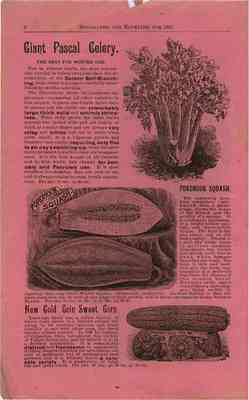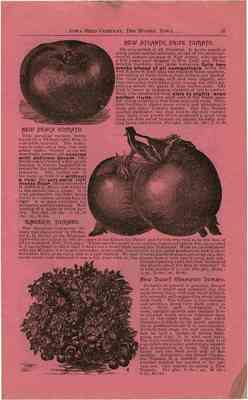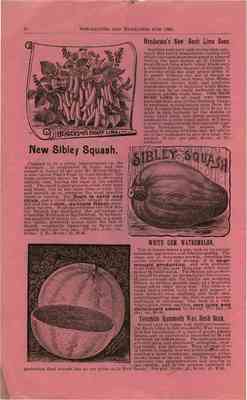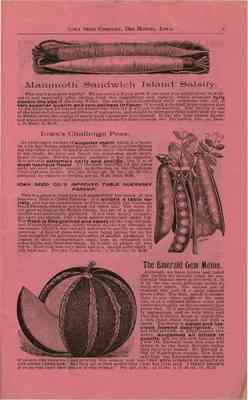Pages
1
[i, front cover]
NOVELTIES • FOR • 1891.
The year 1800 brought out but few really desirable vegetable novelties to be offered for 1891 for, although there were many catalogued by American seedsmen last spring, a test of them reveals but few of merit for this section of the country. This list will be found to contain “the cream” of all the novelties as well as some varieties of recent introduction to which we direct your special attention, many of them being of our own introduction and now listed by some of the most prominent seed firms in the country as varieties of sterling merit. We most earnestly recommend all of the following varieties to our customers and it will pay you to try them this year.
IOWA SEED CO.’S
Market Gardener’s Beet.
[image (Market Gardener’s beet)]
[text in image: MARKET GARDENERS’ BEET]
This is undoubtedly one of the best novelties ever introduced, and it receives much praise from our customers each year. Its shape is well illustrated by the accompanying engraving. As will be noticed, it is very symmetrical, with small tap root and but few fibrous roots. Unusually small tops. Although on some soils the Egyptian Can be marketed a few days before the Market Gardeners, still within a week it will be found larger than the Egyptian, while it continues to grow until late in the fall, attaining a large size and making a good selling and eating beet for winter. By the first of October they measure eight inches in diameter and average six pounds each in weight. One sowing only is necessary to produce early beets for market and main crop for winter use, which is not the case with any other variety. Color outside is deep blood-red; inside layers of blood-red and light red alternately. When cooked they are a beautiful dark red throughout, fine grained and unsurpassed in quality. As this variety grows almost entirely under ground, it should be grown in light, loose soil. It will not do well in hard, clayey soil. Summing it all up, we find in it the Best Beet for Early Market, the Best Beet for Winter Use, and owing to the small tops permitting them to be grown close together. and the peculiar shape of the bulb, it is the Most Profitable Beet for the Market Gardener and for the family garden of any we know of.—Mr. E. S. Goff, of the Geneva Experiment Station says: “It is short conical variety of large size and quick growth.” Wm. Henry Maule says: “I consider it the best general purpose beet in cultivation.” Everyone should try at least a packet. Per packet, only 5c; oz. 15c; ¼ lb, 50c; lb,[.] $1.50.
Mammoth Red Rock Cabbage.
[image (one head of Mammoth Red Rock cabbage)]
A market gardener’s strain of unusual size, color and weight. The result of careful and intelligent selection, it must prove to be very valuable, its handsome appearance, large size, solidity and good quality will make it very desirable to all who like red cabbage. Color is very dark red. It will pay all gardeners to try this. Seed very scarce this year. Per pkt, 10 cts; oz, 60 cts; ¼ lb. $2.00.
COPPER KING ONION.
[image (one Copper King onion)]
Undoubtedly the largest variety in existance [existence], , having been grown to the enormous weight of five pounds and six ounces, and notwithstanding their large size they retain their perfect shape and fine quality, and do not become ungainly monstrosities. To obtain some idea of how large this really is, just weigh the largest onion you can obtain and compare weights or weigh out five pounds and six ounces of common onions and imagine them all in one. They are a beautiful copper color; flesh pure white, fine grained and mild. Per pkt, 10 cts; oz. 35 cts ; ¼ lb, 75 cts. lb. $2.60.
2
ii [, inside front cover]
Specialties and Novelties for 1891
Giant Pascal Celery.
[image (bunch of celery )]
[text in image: VC]
[text in image: Thiebault]
THE BEST FOR WINTER USE.
This is without doubt, the most remarkable novelty In Celery obtained since the in introduction of the Golden Self-Blanching from which It is a sport, carefully established by skillful selection.
The illustration shows Its handsome appearance,—surpassing all other varieties in this respect; It grows one-fourth taller than Its parent and the stalks are remarkably large thick, solid and entirely stringless. When fully grown the outer stalks average two inches wide and are nearly thick as a man’s finger and are always Very crisp and brittle and can be eaten when quite small. It is a vigorous grower and blanches very easily, requiring only five to six day’s earthing-up, when the outer stalks present a beautiful clear-white appearance. It is the best keeper of all Celeries and is, with doubt.[,] THE CELERY for January and February use. It is most excellent for shipping, does not rust or rot, and it always retains its crisp, brittle appearance. Per pkt. 10 cts; oz. 50 cts.
FORDHOOK SQUASH.
[image (cut halves of Fordhook squash showing internal and external view)]
[text in image: FORDHOOK SQUASH•]
[text in image: COPYRIGHTED 1889]
[text in image: W. ATLEE BURPEE & CO]
The engraving herewith, accurately reproduced from photograph shows the shape of the Squash and the solidity of a section. It is extremely handsome, of a bright yellow outside and straw-yellow within. The flesh is dry and sweet and of the best quality. Placed In a cool, dry room, keeps in perfect condition throughout the winter and spring, until late in June, when Summer Squashes are ready. The stem is thin and hard, and also the roots, consequently it is perfectly free from the attacks of the squash borer. Matures early and is everywhere a sure cropper, being earlier in ripening than any other Winter Squash. Immensely productive. Another feature is that the green squashes can be used any stage of their growth, and in flavor are superior to any Summer Squash. Per pkt. 10 cts; oz. 25c; ¼ lb. 75c; lb. 2.50.
New Gold Coin Sweet Corn.
[image (husked ear of Livingston’s Gold Coin sweet corn atop edge views of stem, broken center and tip of ear)]
[text in image: LIVINGSTON’S GOLD COIN SWEET CORN.]
[text in image: A.BLANC]
Years ago there was a yellow variety of Sweet Corn grown to a limited extent, but owing to its extreme lateness and great liability to mix with other corn, the stock become almost extinct. In 1889 Livingston, of Columbus, Ohio, introduced this variety of Yellow Sweet corn, and we believe it to be a decided acquisition. It is remarkably distinct and handsome in appearance, in these respects exciting the admiration not only of gardeners but of professional seed growers, and it is without doubt, a valuable variety. It is productive, of large size and quite sweet. Per pkt. 10 cts., pt. 30 cts, qt. 5 cts.
3
iii
Iowa Seed Company, Des Moines, Iowa.
NEW ATLANTIC PRIZE TOMATO.
[image (one New Atlantic Prize tomato)]
The very earliest of all tomatoes. It is the result of many years careful selection by one of the most successful tomato growers of New Jersey, who has for a few years past shipped to New York and Philadelphia markets, fine, large tomatoes, fully two weeks ahead of all competitors, being the first Northern fruit that has reached those markets, and selling at from three to four dollars per basket. The vines grow strong, stiff, and very rapidly, setting the crown fruit when quite young, the buds appearing before the plant is four inches high. The fruit is borne in immense clusters of ten to twelve. Each vine producing from sixty to eighty large perfect fruits, very solid and of the finest quality, being unusually free from core and seeds. When first fruiting it ripens more evenly and abundantly than any other Tomato known. Our Des Moines market gardeners say that this is the only variety they have ever grown which produced a good crop from the first set of blooms on plants, thereby netting them high prices. Per pkt., 10c; oz., 35c; ¼ lb. $1
NEW PEACH TOMATO.
[image (two tomatoes on one stem)]
This peculiar variety, introduced by a Philadelphia firm, is a decided curiosity. The tomatoes in color are a deep rose and golden amber, blended in an undescribable [indescribable] manner, all covered with delicate bloom. like the bloom or furze of a fine peach making it almost impossible to recognize the detached fruits as tomatoes. For eating out of the hand as fruit it is without a riva![rival], the very so!id[solid], rich meaty flesh, being unequalled in delicacy of flavor, and melting in the mouth like a grape. It is very productive, the fruit being borne in clusters of from four to eight[.] It is most excellent for preserves and for canning. Well worthy of a place in every garden. Per pkt., 10 cts.; ½ oz., 20 cts.; oz.; oz., 35 cts.
IGNOTUM TOMATO
The Ignotum (unknown) Tomato was discovered by Professor L. H. Bailey at the Michigan Agricultural College in 1887 as a sport of the Eiformige Dauer, and by him reported to be the best of 170 sorts tested. Prof. Taft says:
From our own experience and the reports of others who have tried it, I am inclined to think that it deserves a front rank among the Tomatoes. With us, as compared with the Mikado, it is larger, smoother, more solid, less subject to rot, more productive, and is more desirable, both as an early and as a late variety. We had several hundred plants growing on a dry, sandy knoll, and although it was a dry year with us, the plants bore a very heavy crop, and continued ripening until the frost destroyed the plants about the first of October.It is well worth a trial. Per pkt., 10 cts.; ½ oz., 25 cts.; oz., 40 cts.
New Dwarf Champion Tomato.
[image (New Dwarf Champion tomato)]
It’s habit of growth is peculiar, for not only is it dwarf and compact, but the stem being thick, stiff and short jointed, it is actually self-supporting when laden with fruit. The foliage is also distinct and peculiar, being very dark green in color, thick and corrugated. Its close, upright growth also enables it to be planted much nearer together than any of the older sorts, and the yield therefore, is likely to be much greater, for in productiveness it is unsurpassed. At their best stage we had plants that had on half a bushel of grown fruit, green and ripe. It is also very early[.] The fruit resembles the Acme, and is of a purplish pink color, and always smooth and symmetrical in form. The skin is tough and the flesh solid and of fine quality. Altogether, the Dwarf Champion Tomato is a decided acquisition, whether wanted for market or for private use. Can almost be called a Tree Tomato. Per pkt., 5 cts.; oz., 30 cts.; ½ lb., 85 cts.
4
iv
Specialties and Novelties 1891.
Henderson’s New Bush Lima Bean,
[image (Henderson’s New Bush lima bean plant)]
[text in image: HENDERSON’S DWARF LIMA.]
Another year only adds to our high opinion of this really remarkable variety with which our customers were greatly pleased during the past season as it yielded a magnificent crop where other kinds were a complete failure because of drought. It is worthy of all the high praise given it. It grows without the aid of stakes or poles, in compact bush form, from fifteen to eighteen inches high and produces enormous crops of delicious Lima Beans which can be as easily gathered as the common garden bush bean. THE NEW BUSH LIMA is at least TWO WEEKS EARLIER than any of the climbing Limas. It produces a continuous crop from the time it comes into bearing (it is fit for the table in this latitude by the middle of July) until frost, and being enormously productive, a very small patch will keep a family supplied with this splendid vegetable throughout the season. The quality is simply delicious, and we advise all of our customers to give it a trial. Per packet, 10 cts; per pint, 40 cts; qt. 70c. postpaid.
New Sibley Squash.
[image (New Sibley squash)]
[text in image: SIBLEY SQUASH]
[text in image: A.Blanc]
Claimed to be a great improvement on the Hubbard. It originated in Iowa, and was named in honor of the late Mr. Hiram Sibley; is also called Pike’s Peak by some dealers. The form, correctly shown by the cut, is obviously entirely new, having the stem at the swelled end. The shell is pale green in color, very hard and flinty, but at the same time so very thin and smooth as to occasion the least possible waste in baking. The flesh is solid and thick, and a vivid brilliant orange in color, dry and has a rich, delicate flavor, peculiarly its own. In productiveness the New Sibley Squash has decidedly the advantage of either the Hubbard or Marblehead. In its keeping qualities it excels all.[,] remaining in a good, dry cellar, perfectly sound until the last of March, constantly improving in flavor and quality until the very last. Per pkt., 5 cts.; oz,[.], 15 cts.; ¼ lb., 35 cts.; lb., $1.00.
WHITE GEM WATERMELON.
[image (White Gem watermelon cut half and whole fruit)]
[text in image: COPYRIGHTED 1888]
[text in image: BY W. ATLEE BURPEE & CO
[text in image: PHILA PA]
This is found indeed a gem, both in its unique handsome appearance and delicious quality. The vines are of luxurious growth, covering the entire surface of the ground. It is enormously productive, and sets probably more fruit to the acre than any other watermelon in cultivation. The melons are perfectly round in shape, as shown in the illustration, of good average size for family use, weighing fifteen to twenty pounds each, of a beautiful cream-white color when ripe. The skin is so tough that a melon fully ripe will support a man without even cracking the flesh—this, notwithstanding that the rind is only a scant half-inch in thickness. The flesh is a rich bright pink, crisp, melting, very juicy and deliciously sweet in flavor. Per pkt., 10 cts.; oz., 40 cts.
Yosemite Mammoth Wax Bush Bean.
Second only in value and distinctiveness to the Bush Lima is this wonderful Wax variety. It is the forerunner of a race of giants among Beans, and is universally conceded to be the novelty of the season. The pods are nearly all solid pulp and absolutely stringless, cooking tender and delicious. They average 10 to 14 inches in length, and are a rich golden color, making a most handsome appearance either on the plant or on the table. The Yosemite combines size, productiveness and quality in one variety, and is the nearest approach to perfection that nature has as yet given us in Wax Beans. Per pkt., 10 cts; pt., 50 cts; qt..[,] $1.00.
5
v
Iowa Seed Company, Des Moines, Iowa.
[image (two Mammoth Sandwich Island salsify)]
Mammoth Sandwich Island Salsify.
Why don’t you grow Salsify? We are certain if you grew it one year you would never be without it, and especially after having tried this magnificent new variety, which averages fully double the size of the Long White. The roots, notwithstanding their enormous size, are of very superior quality and very delicate in flavor; it is such a decided improvement that we are quite sure all market gardeners who once try it will use it exclusively. The Salsify is one of the most delicious and nutritious of vegetables, and should be more generally cultivated for use in winter, when the supply of really good vegetables is so limited. It has the true oyster flavor; and makes a delicious and inexpensive substitute for them in soups, etc. Per packet, 5cts; oz., 15cts, ¼ lb. 50cts; lb. $1.50.
Iowa’s Challenge Peas.
[image (Iowa’s Challenge Peas)]
[text in image: A.BLANC]
An extra early variety of superior merit, which is a favorite with Des Moines market gardeners. We can in all confidence say that after a trial of nearly all extra early varieties offered to the trade, we have not found one possessing more merit, hence its name. For the market gardener it has no superior. It is not only extremely early and prolific, but it is of most luscious flavor. All the good qualities of the extra early are most nearly brought to perfection in the Challenge. Vines eighteen inches. Per pkt, 10 cts.; pt. 30 cts.; qt. 50 cts.; postpaid; by express or freight, per pk. $1.40; bush. $5.00.
IOWA SEEDS CO.’S IMPROVED TABLE GUERNSEY PARSNIP.
This is a greatly improved and wonderfully fine strain of the Guernsey Hollow Crown Parsnip,[.] It is strictly a table variety, and has no resemblance to what is called the Guernsey Stock Parsn1p [Parsnip], which is not good for table use. The roots do not grow as long as the Hollow Crown, but are of a greater diameter and more easily gathered. It is a very heavy oropper [cropper]; the roots are smooth, with a deep, hollow crown and small top. The flesh is fine grained and sweet all the way through, and of excellent quality. Cooks evenly all the way through to the center, which is fine and soft and even in quality as outside portions. A field of these which were being grown for us for seed attracted the universal attention of market gardeners by reason of their extraordinary small tops, as compared with other kinds, and their fine shape. It is sure to please all who try it. Seed crop was very short and you should order early if you want any. Per pkt. 5 cts.; oz. 15 cts.; ¼ lb. 35 cts.; lb. $1.00
The Emerald Gem Melon.
[image (whole Emerald Gem melon with slice cut showing profile)]
Although we have grown and listed this variety for several years we continually become more in love with it. It is by far the most delicious melon we have ever eaten. The melons are of medium size and of a deep emerald green color The flesh, which is thicker than in any other melon of the same size, is of a suffused salmon color, and ripens thoroughly to the extremely thin green rind. It is peculiarly crystalline in appearance, and so very juicy and ripe that it almost drops to pieces (like a rich cake) when dipped out with a spoon. The flavor is sweet and luscious beyond description. On our trial grounds, in Adair county, this melon surpassed all others in quality, and we are sure that all who grow the Emerald Gem this year will praise it as the finest flavored melon they have ever tasted. Mr. Edward L. Coy, of Washington county, New York, says that “the Emerald Gem ripened first of twenty-two varieties I had growing this season, and was very much superior in quality to any other i ever saw. But they are so thick meated they yield but little seed. I verily believe it to be the nery [very?] best melon in the world.” Per pkt. 5 cts; oz. 15 cts; ¼ lb. 45 cts; lb., $1.25.




